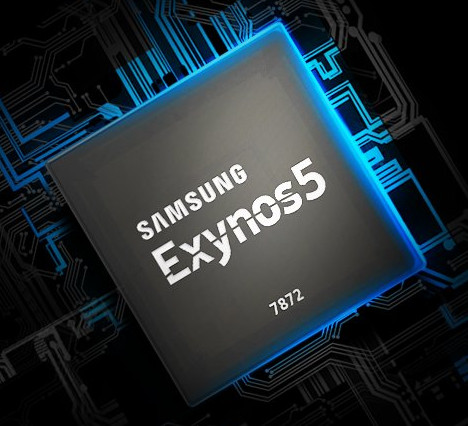Samsung has introduced a new hexa-core Exynos 5 series processor with Exynos 7872 featuring two Cortex A73 cores, four Cortex A53 cores, a Mali-G71 MP1 GPU, and an LTE modem that supports Category 7 with 2CA for 300Mbps downlink speed and Category 13 with 2CA for 150Mbps.
The new processor claims to bring premium performance to mid-tier device with a doubling of single core performance compared to its predecessor, which should be Exynos 5430 or Exynos 5422 octa-core Cortex A15A/7 processor.
 Samsung Exynos5 7872 processor specifications:
Samsung Exynos5 7872 processor specifications:
- CPU – Dual-core Cortex-A73 @ up to 2.0GHz, and Quad-core Cortex-A53 @ up to 1.6GHz
- GPU – Arm Mali-G71 MP1
- Memory I/F – LPDDR3
- Storage I/F – eMMC 5.1, SD 3.0
- Display – Up to WUXGA (1920×1200)
- LTE Modem – LTE Cat.7 2CA 300Mbps (DL) / Cat.13 2CA 150Mbps (UL)
- Connectivity – Wi-Fi 802.11n Dual-band, Bluetooth 5, FM Radio
- GNSS – GPS, GLONASS, BeiDou, Galileo
- Camera – Rear 21.7MP, Front 21.7MP
- Video – Full HD 120fps encoding and decoding with HEVC (H.265), H.264 and VP8, and decoding with VP9
- Process – 14nm FinFET Process
One of the first phone based on the processor will be Meizu M6s with a 5.7″ HD+ display (18:9 aspect ratio), 3GB of RAM and 32GB / 64GB flash, a 16MP rear camera, 8MP front-facing camera, and a 3,000 mAh battery. It would also be a nice (and affordable) update to ODROID-XU4 board based on Exynos 5422 SoC, we’ll have to wait and see.

Jean-Luc started CNX Software in 2010 as a part-time endeavor, before quitting his job as a software engineering manager, and starting to write daily news, and reviews full time later in 2011.
Support CNX Software! Donate via cryptocurrencies, become a Patron on Patreon, or purchase goods on Amazon or Aliexpress




